
Pothos : planting, growing and propagating this easy-care houseplant
Contents
The Pothos in a Nutshell
- It charms with its lush, variegated or solid foliage and vigorous growth.
- The Pothos needs brightness, well-drained soil, and spaced-out watering.
- Taking cuttings of Pothos in water or directly in soil is child’s play.
- Undemanding, it tolerates dry air and resists diseases well.
- Versatile, it fits perfectly into every room of the house.
The word from our expert
An essential houseplant, the Pothos (Epipremnum aureum) captivates with its lush foliage and adaptability. Whether climbing or trailing, the Pothos offers multiple decorative possibilities: you can train a Pothos to climb a natural support or let it cascade gracefully from a hanging pot.
In terms of care, the Pothos is undemanding: good light, moderate watering, well-draining soil, and a stable environment around 20°C are all it needs to thrive. It tolerates dry air and is rarely affected by diseases, making it an ideal plant for beginner gardeners. Few plants are as easy to care for! Each variety of Pothos, such as ‘Marble Queen’, ‘Neon’, or ‘Golden’, brings a unique aesthetic and fits effortlessly into any interior, from the most understated to the most exotic.
Easy to propagate, growing a Pothos in water is an ideal way to create new young plants from a simple stem. Once well-rooted, it can be transferred to a pot for more sustainable growth.
A true botanical chameleon, the Pothos fits in anywhere: bathroom, kitchen, bedroom, or conservatory. Whether you’re looking for a natural air-purifying plant, an easy-care option, or simply a decorative one, the Pothos ticks all the boxes. Choose the Pothos that appeals to you and adopt this beautiful houseplant today!
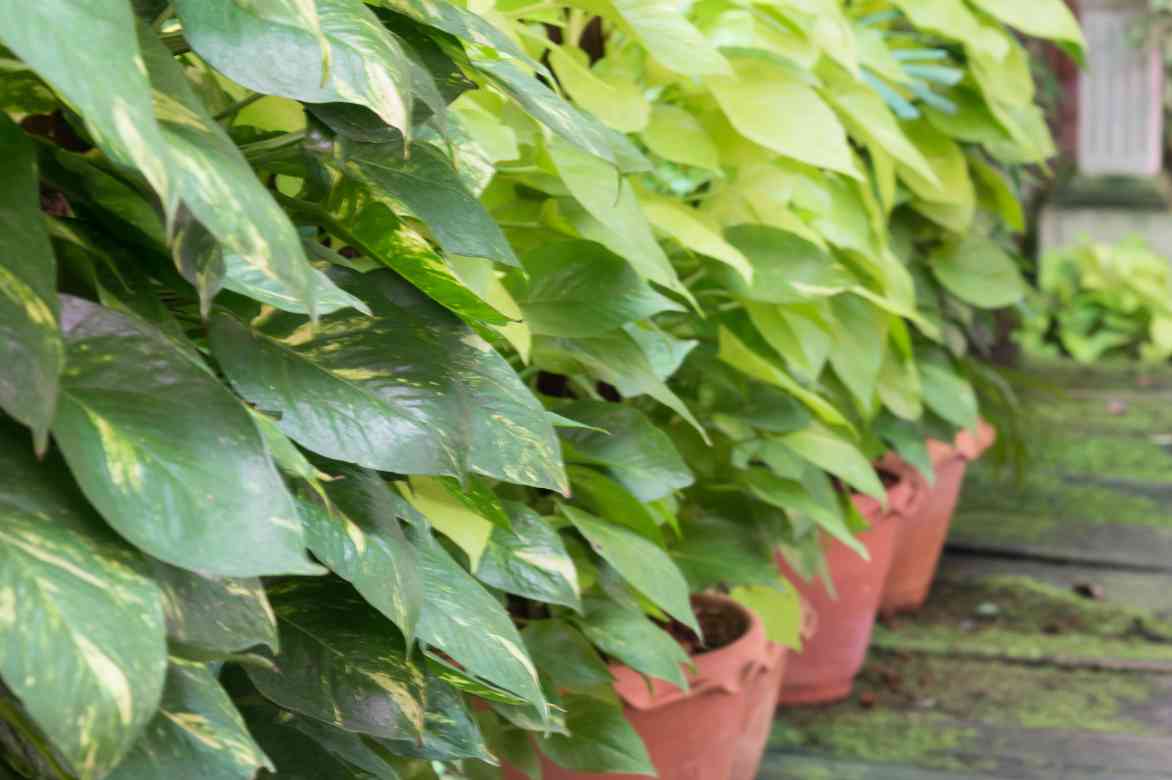
Epipremnum aureum
Botany and description
Botanical data
- Latin name Epipremnum aureum
- Family Araceae
- Common name Pothos, Scindapsus, Devil's Ivy
- Flowering rare indoors
- Height Up to 2 to 3 metres indoors
- Exposure Bright
- Soil type Light, well-draining and aerated substrate, a mix of potting soil, perlite and sand or clay pebbles
- Hardiness Frost-sensitive
The Pothos (Epipremnum aureum or Scindapsus) belongs to the Araceae family, a large botanical family that includes many tropical plants, such as the Monstera, famous for its large, split leaves, or the Anthurium, recognisable by its shiny, heart-shaped flowers. The genus name comes from ancient Greek, literally meaning “on trunks”, referring to its natural epiphytic growth habit, clinging to trees to climb in search of light. It is also known by the nicknames “Devil’s Ivy” or “Golden Pothos“. For a long time, Pothos was called Scindapsus aureus in commerce, before it was realised that it was actually an Epipremnum aureum.
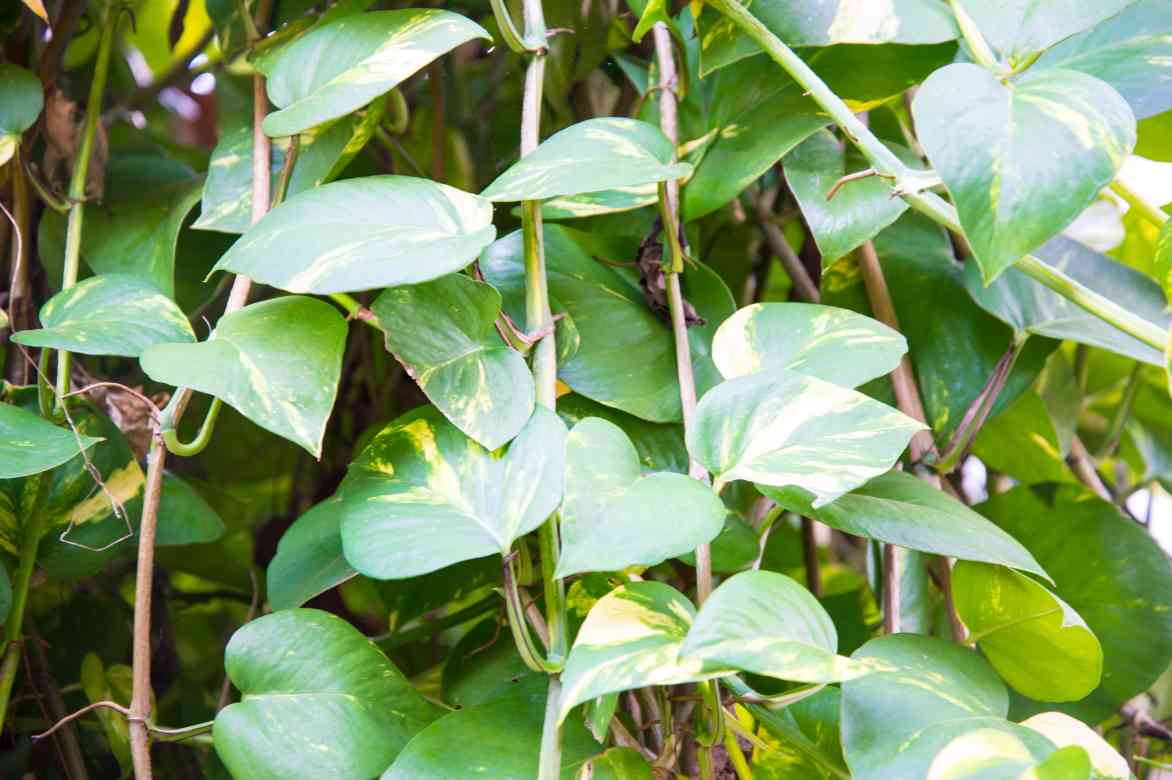
Epipremnum aureum
Native to Southeast Asia, more specifically the Solomon Islands and neighbouring tropical regions, this plant thrives naturally in humid forests, where it climbs vigorously along tree trunks while benefiting from dappled light filtered through the canopy. Its natural environment is therefore warm, humid, and partially shaded, which largely explains its ideal adaptation to our indoor spaces.
If Pothos is grown indoors, it is mainly due to its sensitivity to cold. It cannot tolerate temperatures below 10 °C. Not hardy, it cannot survive outdoors in temperate climates. It is therefore in our living rooms, offices, or conservatories that it finds the conditions conducive to its development.
Pothos Varieties
The Epipremnum genus includes around fifteen species, but only a handful are commonly grown indoors. Among them, Epipremnum aureum is by far the most widespread, often sold in different varieties distinguished by their colours and leaf patterns:
- The ‘Golden Pothos’ variety is probably the most common. It features bright green leaves variegated with golden yellow, luminous and very decorative. It is often mistakenly considered the natural form of the species, whereas it is a variety selected for indoor cultivation.
- ‘Marble Queen’ has leaves generously marbled with creamy white. It requires a little more light to maintain its sharp variegation.
- ‘Neon’ stands out with its chartreuse-green leaves, almost fluorescent.
- ‘Jade’ or ‘Green Queen’ offers uniform dark green foliage, understated but elegant, while ‘N’Joy’ and ‘Pearls and Jade’ display very pronounced variegation, blending pure white with dark green in sometimes irregular patterns.
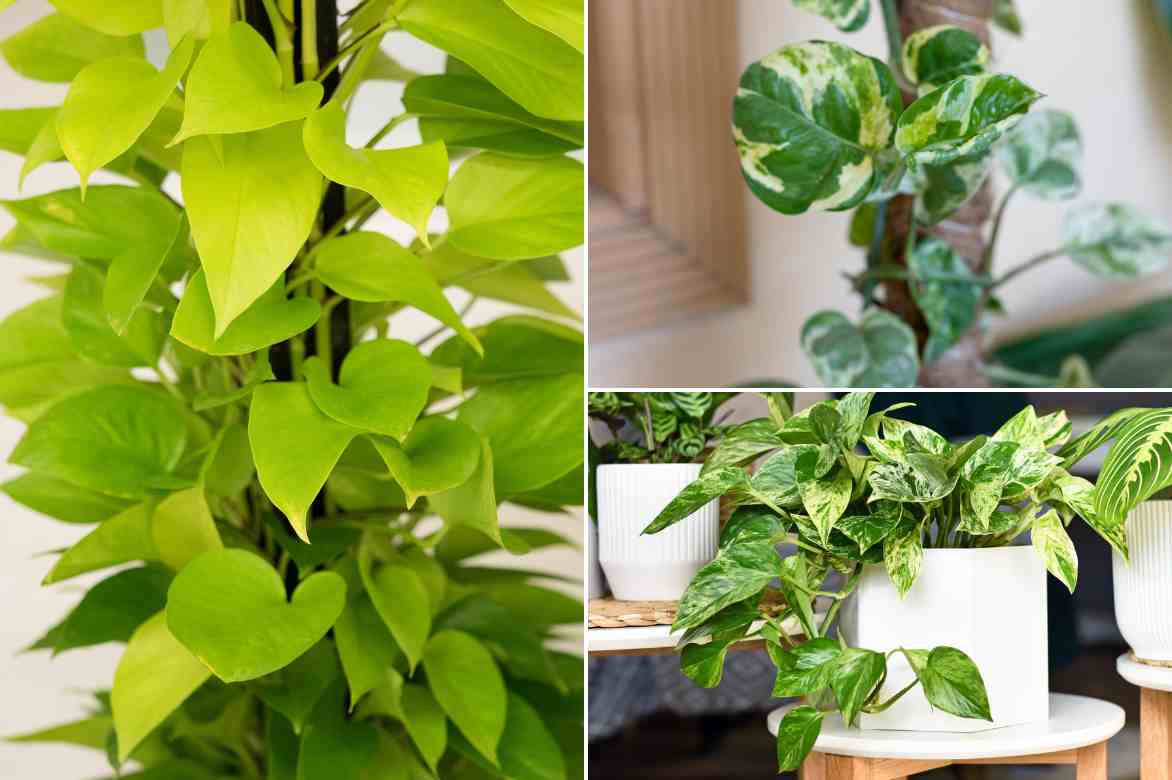
Photos ‘Neon’, and on the top right ‘N’Joy’ and at the bottom ‘Marble Queen’
These more compact varieties are particularly well-suited to small spaces or hanging cultivation.
Pothos has a flexible and sarmentous habit, with a naturally climbing or creeping growth depending on the supports it encounters. Its stem, initially flexible and green, gradually becomes semi-woody at the base with age. It can extend several metres under favourable conditions, with no real size limit in indoor cultivation, although it is often kept between one and two metres in height. Adventitious roots regularly develop in the leaf axils, forming an aerial network that allows it to anchor itself to surrounding supports in its natural habitat or to capture ambient humidity indoors.
Its growth is rapid: under favourable conditions, its stems can gain several dozen centimetres in a few weeks. The underground root system is fasciculate, dense, and fibrous, capable of occupying the pot volume well. It tolerates temporary substrate asphyxiation, which explains its resilience in domestic cultivation.
The foliage, evergreen, consists of alternate, simple leaves, with a cordate to ovate lamina, a leathery texture, and a glossy surface. In juvenile specimens, the leaves measure generally between 8 and 15 centimetres long, but they can reach 30 to 40 centimetres in length in well-developed adult specimens. Their edges are entire, and their pinnate nervature is clearly marked. The colour varies from bright green to green variegated with yellow or white, depending on the cultivar.
In its natural environment, it can produce gigantic, split leaves, very different from those we know indoors. These leaves can exceed a metre in length when it climbs high in the tropical forest, hinting at the full potential of this often modest plant in our homes but truly majestic in nature.
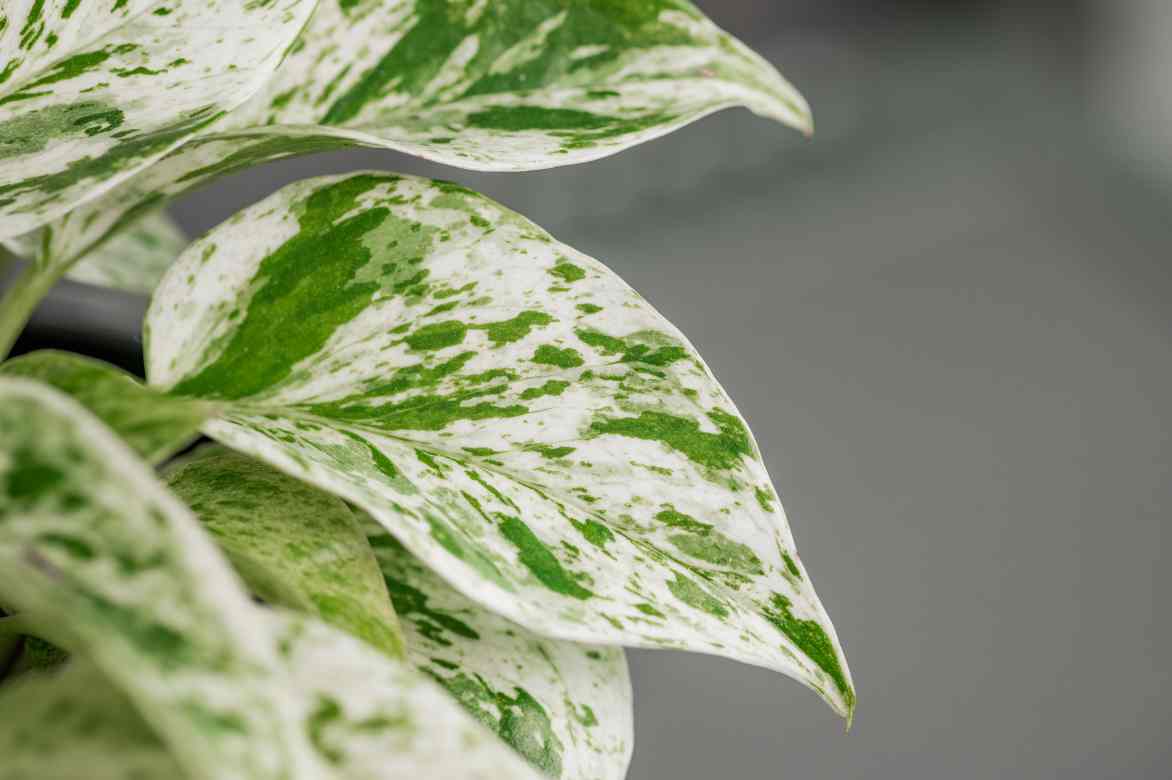
Pothos ‘Marble Queen’
Indoors, flowering is extremely rare, if not non-existent, as it requires light and maturity conditions rarely achieved. In its natural environment, it produces a typical Araceae inflorescence, consisting of a spadix of creamy yellow surrounded by a pale, usually discreet spathe, lanceolate in shape and slightly fleshy. The flowering is not decorative, and in cultivated specimens, it is generally replaced by sustained vegetative growth. Fruiting, in the form of small berries clustered on the spadix, occurs only under specific tropical conditions and remains exceptional outside its natural habitat.
Pothos also stands out for its air-purifying abilities. It is particularly effective at absorbing certain volatile organic compounds, notably formaldehyde present in indoor air.
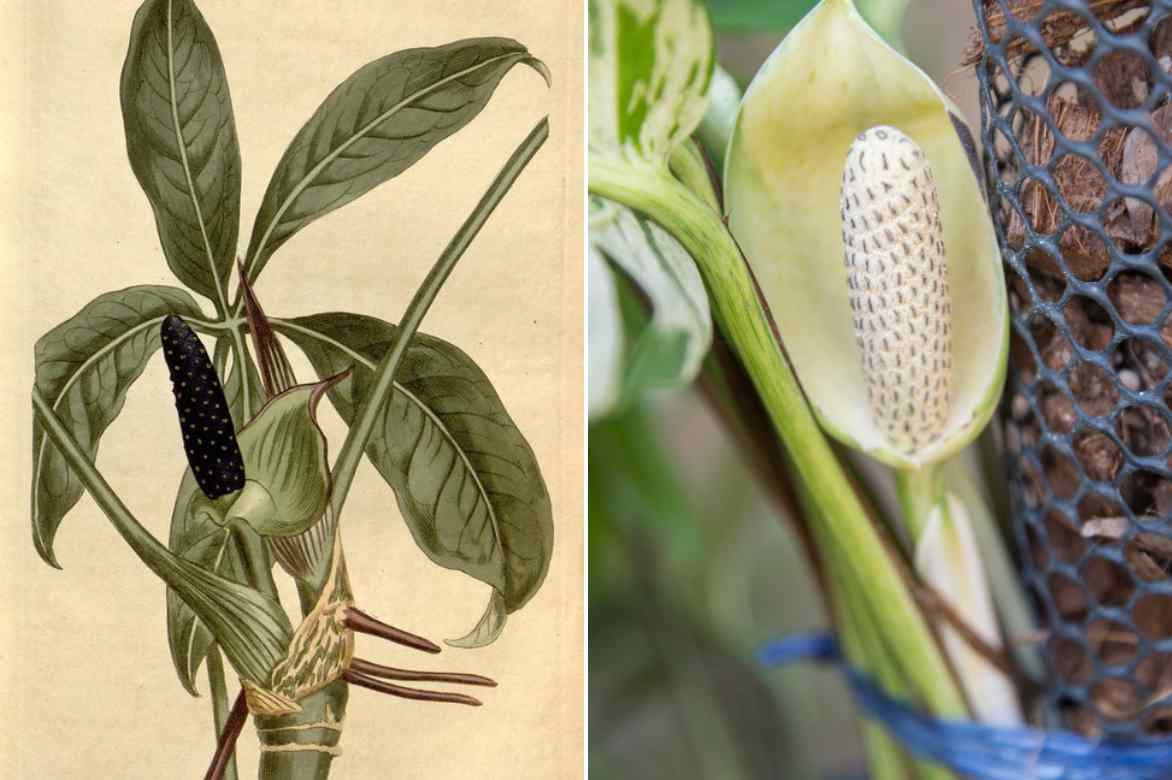
Botanical plate of a Pothos pentaphylla and on the right the flowering of an Epipremnum pinnatum
Most popular varieties
Planting Pothos in Pots
Where to Place the Pot?
Due to its complete lack of hardiness, the Pothos can only be grown outdoors in equatorial regions or in tropical greenhouses. In our latitudes, it is reserved for indoor cultivation, where it finds more stable and protected conditions. The plant cannot tolerate temperatures below 10–12°C and begins to suffer below 15°C, making it very sensitive to cold.
The Pothos thrives in bright environments but away from direct sunlight, which could scorch its foliage. It tolerates medium light well, and even low light, although its growth will slow noticeably. Varieties with strongly variegated foliage, particularly those with white patterns, require brighter light to maintain the intensity of their markings.
The ideal temperature for its cultivation ranges between 18 and 29°C, a comfortable range in most homes. It also adapts to moderate humidity levels, around 50 to 70%, but tolerates drier atmospheres without issue, making it a plant well-suited to apartment living.
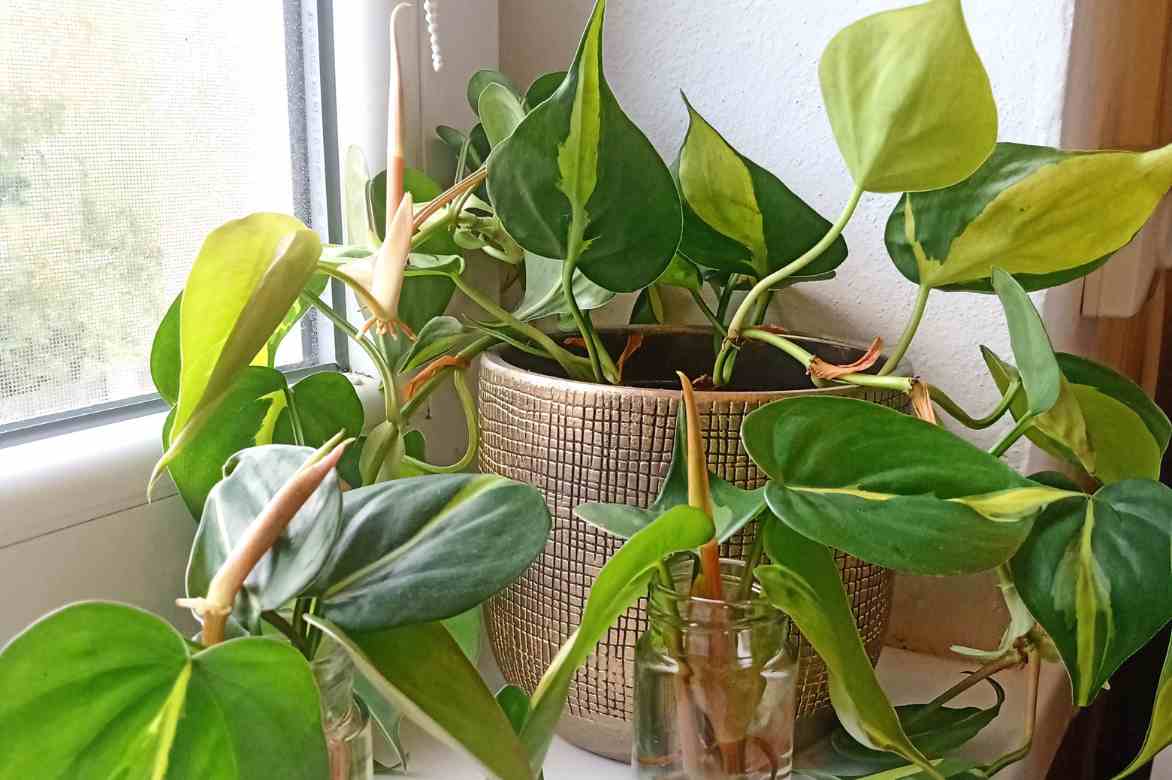
A bright location without direct sunlight is ideal for the Pothos
When to Plant a Pothos in a Pot?
Planting can be done year-round indoors, but spring is the ideal time to plant a Pothos in a pot, as temperatures begin to warm and the risk of frost has passed. The plant then enters its active growth phase, which facilitates rooting and adaptation to the new substrate.
Which Substrate to Choose?
The substrate should be airy, well-draining, and slightly rich. This type of substrate helps avoid waterlogging while maintaining sufficient moisture around the roots. Here’s an ideal composition to ensure good root development for the Pothos:
- Indoor plant compost
- 20% Perlite or vermiculite to lighten the mix and improve air retention.
- Coarse sand or clay pebbles to enhance drainage.
How to Plant the Pothos?
- Choose a pot with drainage holes to prevent water stagnation.
- Place a layer of clay pebbles or gravel at the bottom of the pot to improve drainage.
- Fill the pot with a light compost mix, enriched with perlite or sand for good root aeration.
- Position the young plant without burying the collar, spreading the roots evenly.
- Water moderately after planting to moisten the substrate without saturating it.
- Place the plant in a bright spot, away from drafts and direct heat sources.
Also read: How to Grow a Pothos?: Pot choice, substrate, repotting.
Cultivation and care
This is a low-maintenance plant, capable of adapting to a wide range of indoor environments.
Watering and Humidity
The Pothos requires moderate and well-controlled watering. It is recommended to let the top five centimetres of soil dry out between waterings. Overwatering can lead to yellowing foliage and the risk of root rot. During the growth period, watering every 7 to 10 days is sufficient; in winter, space it out further. Misting the foliage is optional, but it can be helpful if the air is too dry, especially in heated homes during winter.
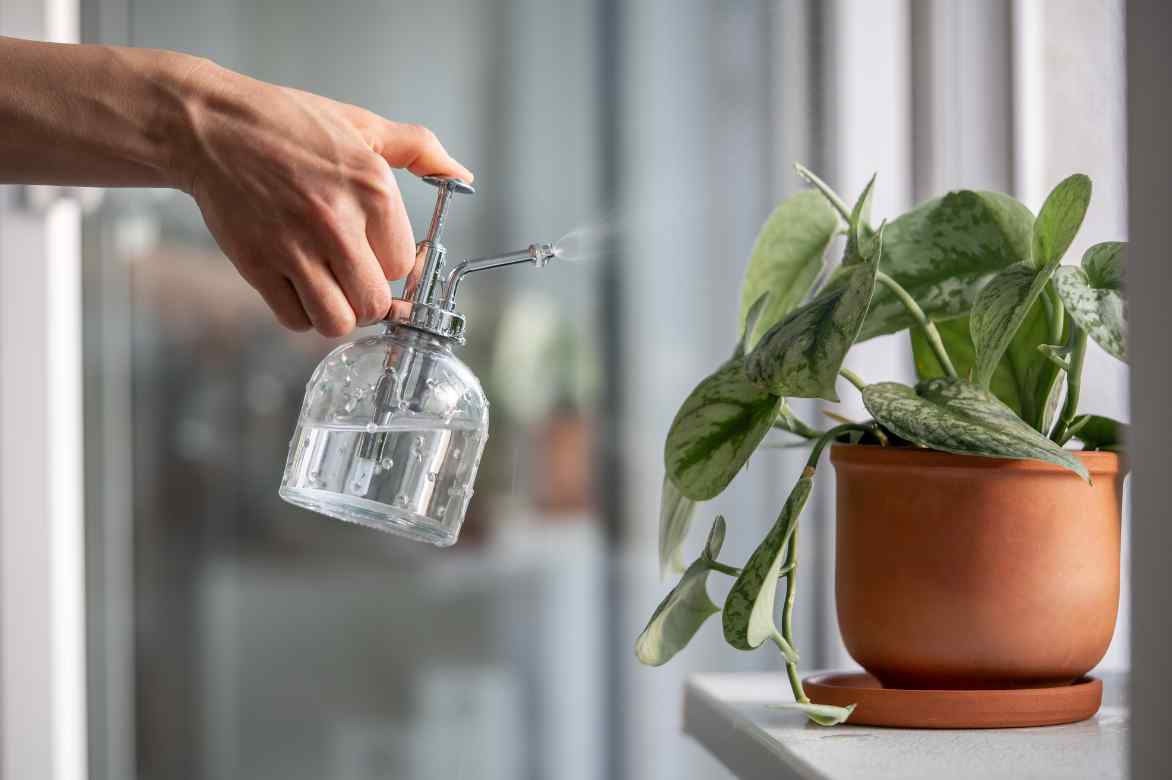
Only mist if your home is very dry
Fertilisation
Although it grows even without additional nutrients, the Pothos appreciates a liquid fertiliser for flowering or green plants, diluted to half strength and applied every 4 to 6 weeks in spring and summer. Fertilising is unnecessary and even discouraged during autumn and winter.
Pruning
Pruning helps maintain a compact habit, encourage branching, or control excessive stem elongation. It is done in spring:
- Cut just above a node, i.e., at the base of a leaf.
- Remove 5 to 15 cm of stem, depending on the length to control or the desired shape.
- Use a clean, sharp tool to avoid damaging the stem.
- The cut stems can be used to create a new Pothos cutting in water or soil, or replanted in the same pot alongside the mother plant to thicken the base. Nothing is wasted!
Tip: When stems become too long or the plant loses density, don’t hesitate to pinch them. This simple action prevents excessive elongation and stimulates branching, helping to maintain a beautiful shape. This means cutting the tip of a young shoot just above a node (the point where a leaf attaches), using your fingers or clean scissors. Result: denser foliage and a more balanced habit.
Repotting
Repotting is advised every two or three years, or as soon as the roots become cramped in their pot. It is preferably done in spring, when the plant enters an active growth phase. Choose a slightly larger container and fresh, well-draining soil to revitalise the plant.
Learn all about repotting in our article: How to repot a houseplant?
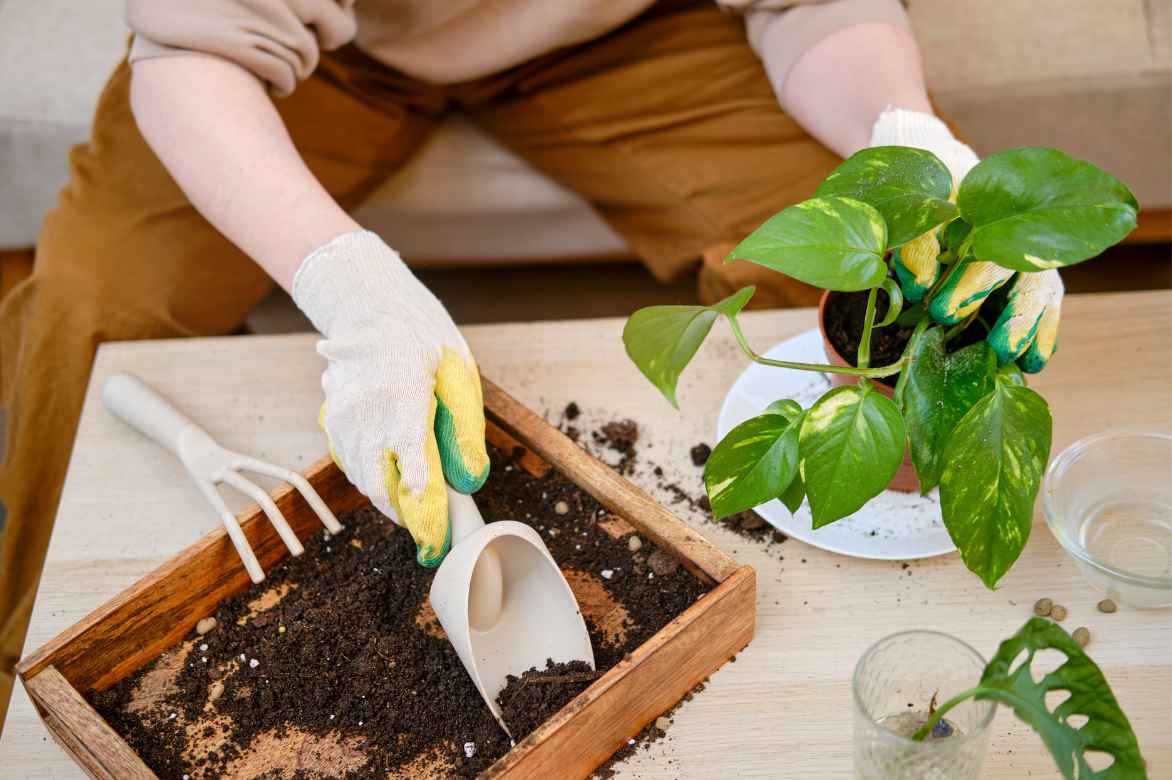
Precautions to Take
- To prevent stems from growing solely towards the light, remember to rotate the pot regularly. This ensures more balanced growth and a harmonious shape.
- If you notice that the leaves are widely spaced on the stems (elongated nodes), this often indicates a lack of light. In this case, shorten the stems and place the Pothos in a brighter spot, but still away from direct sunlight.
- Occasionally wipe the leaves with a slightly damp soft cloth to remove dust and promote the plant’s respiration.
- The Pothos dislikes cold and drafts, as well as direct sunlight, which can scorch its leaves.
- It is also important not to let water stagnate in the saucer after watering.
Parasitic and Potential Diseases of Potted Pothos
The Pothos is generally a resilient plant, but it can occasionally fall prey to a few common parasitic pests. Mealybugs and red spider mites are the main unwelcome visitors to watch out for, especially in dry air or when the plant is stressed:
- Mealybugs: Mealybugs: Identification and Natural Treatments. Solution: Remove them manually using a cotton swab dipped in 70° alcohol.
- Red spider mites: For more details, read Red Spider Mites: Identification and Treatment. Solution: Increase humidity around the plant and treat with a homemade solution of black soap.
Regarding diseases, excess water is the main enemy: it can cause root rot or encourage the growth of fungi responsible for leaf spots. Proper aeration of the soil and well-measured watering are usually enough to prevent these issues.
How to take a cutting from a golden pothos?
The Pothos propagates very easily from stem cuttings. Two methods are available to you: propagation by cuttings in soil for direct potting or cultivation in water.
Pothos Cuttings in Soil
Propagation by cuttings in soil is a simple and quick method to obtain new young plants from an existing stem. Here’s how to proceed:
- Cut a healthy stem of 10 to 15 cm with at least one node.
- Remove the lower leaves, keeping only those at the tip.
- Plant the base of the cutting in a mixture of light and moist potting soil, ensuring the node is buried.
- Gently firm the substrate around the stem to hold it in place.
- Place the pot in a warm (ideally between 20 and 25 °C) and bright spot, away from direct sunlight.
- Optionally cover the pot with a transparent plastic bag to create a humid atmosphere conducive to rooting.
- Water lightly to keep the substrate moist, without overdoing it.
- The first roots usually appear within one to two weeks.
- Once the roots are well-developed, the young plant can be repotted into a larger pot with suitable substrate and cared for like an adult plant.
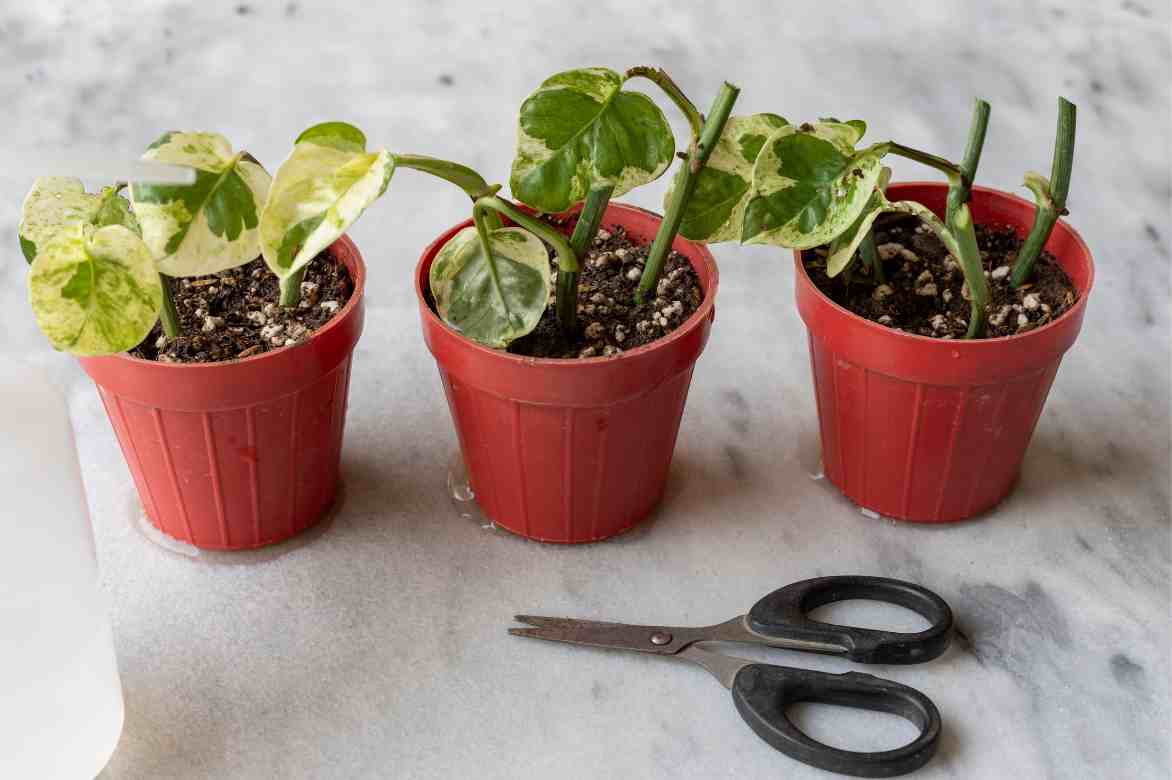
Growing Pothos in Water
Pothos also adapts very well to hydroponic cultivation. Here’s how to do it:
- Take a stem of about 15 cm with one or two nodes.
- Remove any leaves that would be submerged to prevent rotting.
- Submerge the node(s) in a container of clear water, preferably in a transparent vase or glass.
- Place the container in a bright spot, away from direct sunlight.
- Change the water every 3 to 4 days to keep it clean and oxygenated.
- When the roots reach 4 to 5 cm, the cutting can be transplanted into a pot with potting soil.
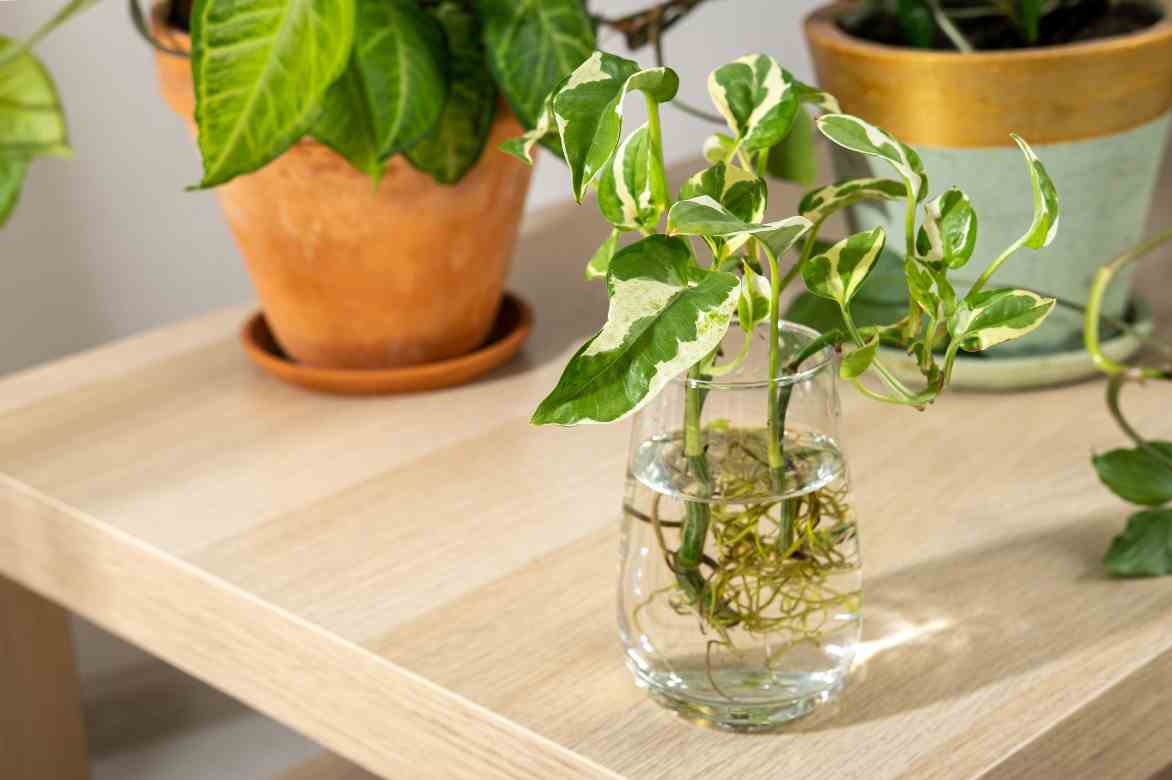
Tips for Successful Pothos Cuttings
Always use clean and well-disinfected tools (knife, scissors) to prevent the spread of diseases. Place your cuttings in a bright environment, but away from direct sunlight, with constant ambient humidity. Avoid overwatering: overly soggy substrate promotes rot and slows down rooting.
How to showcase your Pothos indoors?
With its flexible habit, long stems, and glossy foliage, the Pothos is an ideal plant for creating both natural and graphic plant compositions. In hanging arrangements, it forms lovely cascades of foliage above furniture, in a bright corner, or lined up on a shelf. You can also train it to climb along a wall or a moss pole to structure a corner of the room or complement a vertical piece of furniture (like a bookshelf or a coat stand). It fits into almost every room in the house.
In a bright bathroom, it thrives in the ambient humidity and loves to create a tropical vibe around a mirror or suspended from the ceiling near the shower. In the heart of a kitchen, it adds a refreshing green touch above high cabinets or on a shelf, while remaining unobtrusive.
It also fits perfectly in an office or bedroom, where its trailing stems bring life without demanding much attention.
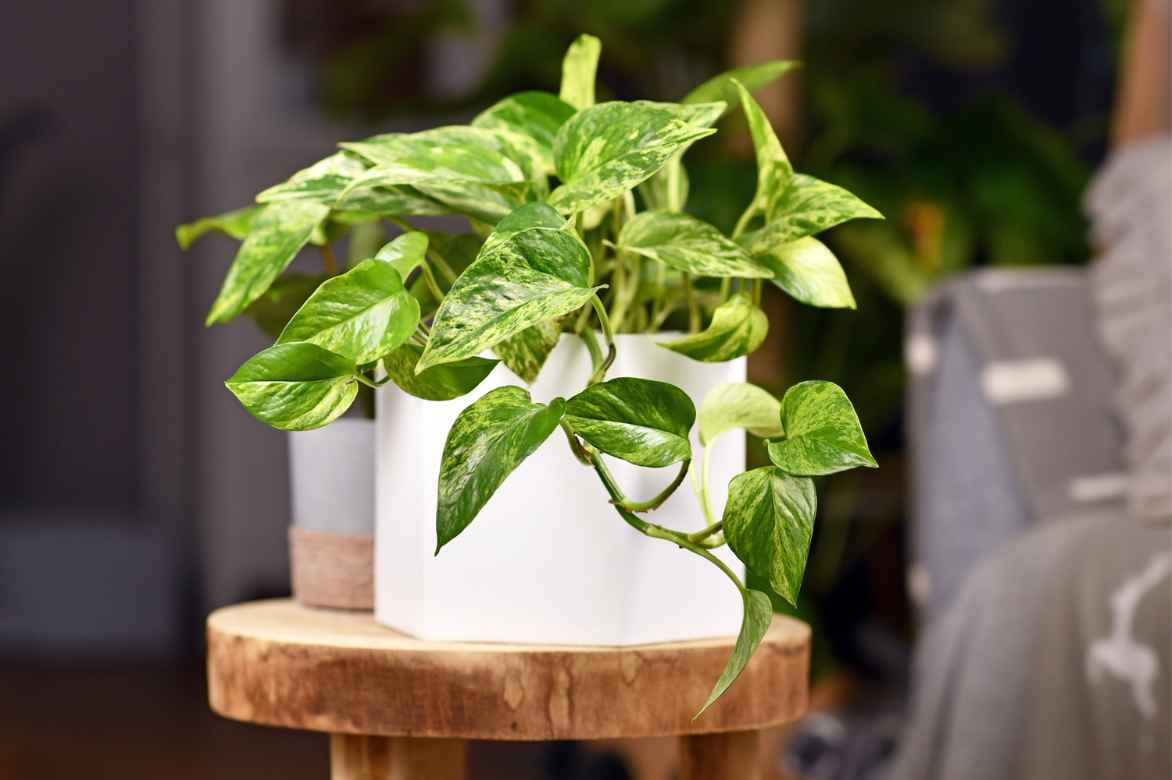
For interiors with a bohemian, contemporary, or minimalist style, the Pothos adapts to everything: a wicker planter, a macramé hanger, a ceramic pot, or simply a natural pole to watch it climb.
Pair it with complementary indoor plants in terms of texture and shape:
-
The Monstera deliciosa for a bold tropical vibe.
-
The Calathea for contrast and graphic richness.
-
The Boston Fern, which enhances the Pothos’ light and airy feel.
-
The Philodendron scandens for a lovely duo in the same hanging arrangement.
-
The Zamioculcas zamiifolia or Sansevieria for a more vertical and structured touch.
For an original display or a chic and lively table centrepiece, tuck a few cuttings into a transparent glass vase filled with water.
Versatile, elegant, and easy to care for… The Pothos truly has it all! Doesn’t that make you want to give in?
Also worth reading
Discover our wide range of houseplants.
Our decorative foliage houseplants and our flowering houseplants.
Our books on houseplants, including the ultimate guide on the subject: The Encyclopedia of Houseplants by Solène Moutardier, published by Ulmer.
Frequently asked questions
-
Why are the leaves of my Pothos turning yellow?
Yellowing of the leaves is often caused by too much water or insufficient light. Allow the top 5 centimetres of the soil to dry out between waterings, and place the plant in a bright spot without direct sunlight. Also, make sure the pot has proper drainage.
- Subscribe!
- Contents































Comments